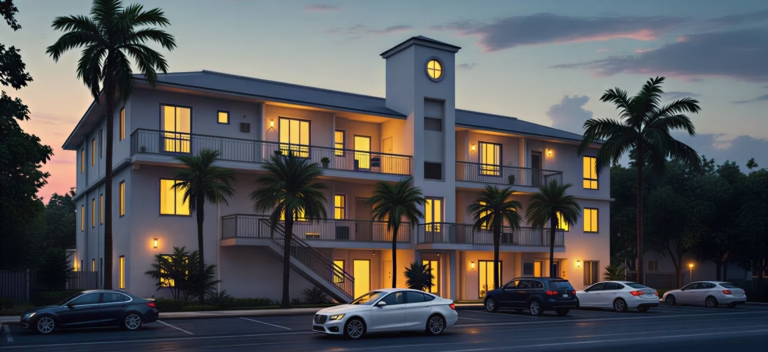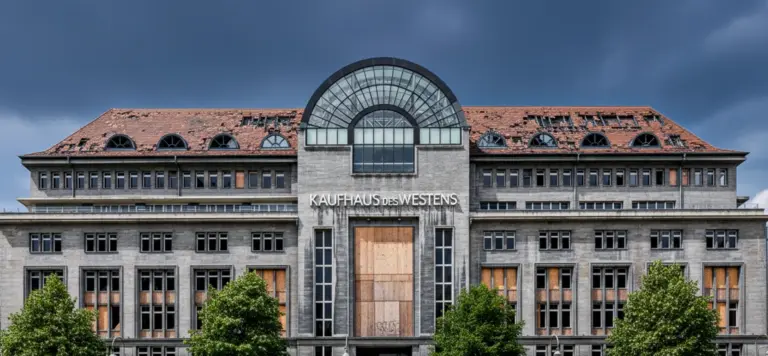Between Headlines and Reality: Why Investors Should Look at the US Real Estate Market Now.
Regardless of your stance on Trump: Anyone who relies solely on headlines operates in a distorted information environment. In Germany, reporting often follows the same pattern, reducing complex political realities to pointed narratives.
The recent BBC scandal demonstrates how susceptible even large media houses are to manipulative editing techniques: Executives had to resign because interviews were intentionally pieced together in a misleading way. This was not a technical error, but targeted distortion – some would even call it systematic framing.

When even renowned institutions stand out for framing, the question arises as to which dynamics investors are still overlooking. While Europe remains bogged down in moral debates, the US has long since shifted its focus back to strategic capital allocation. Capital follows returns – not outrage generated on talk shows.
This is precisely where the opportunity lies: Anyone who analyzes fundamental data instead of headlines immediately recognizes why the US real estate market currently offers an exceptional entry window.
Fundamental Demand – Why the US Housing Market Is Structurally Undersupplied
Over three million housing units are missing in the US – a structural deficit regularly confirmed by government agencies like HUD and studies by Freddie Mac.
Since the 2008 financial crisis, construction has been significantly lagging, and even a doubling of housing starts would not close the gap: There is a lack of labor, materials, and financing scope. Supply remains tight – and scarcity drives real estate values.
In parallel, the Sunbelt – the South of the US – is growing rapidly. Metropolises like Tampa, Nashville, Austin, or Charlotte gain tens of thousands to hundreds of thousands of new residents every year (Census Bureau, Redfin, IRS Migration Reports).
This trend is not random but the result of decades of location policy: business-friendly frameworks, low or no income tax, strong job markets, attractive cost of living, and a climate that attracts people. Investors there position themselves in markets whose growth is politically, economically, and demographically fostered – not hampered.

This dynamic is even intensifying daily. In the US, about 1,000 more people reach adulthood than enter retirement every day – a clear indication of a structural rejuvenation of the population. This young, mobile generation is met with immigration, high internal migration, and ongoing urbanization.
The result is robust household formation: People move out, move in together, or move to new cities; families are formed; career starters change regions; immigrants establish new households. Every newly formed household requires housing – entirely independent of whether the total population is growing or stagnating. This is precisely why rental demand is reliably and broadly increasing.
While Europe discusses recession, young Americans are starting families, changing jobs, and moving to growth regions – and they need housing there.
Stable cash flows are therefore generated not by political promises, but by simple market mechanisms: more people, fewer homes, rising rents.
Attractive Return-Risk Profile – Why Investors Profit Twice Now
Valuations in the US multifamily market are back at a level we haven’t seen for a long time: Cap rates are currently around 150 to 200 basis points above the pre-COVID level – with simultaneously strong historical fundamentals. For professional investors, this is not a risk indicator, but a clear entry point with an attractive risk-return ratio.
New construction continues to lag far behind demand: Since the interest rate reversal, housing starts have collapsed by around 70–80% according to the U.S. Census. High financing costs, expensive materials, and stricter credit approvals have put hundreds of projects on hold. This massively limits the future supply – a clear advantage for existing asset investors. Those who hold cash flow-strong assets today operate in a market with less competition, stable occupancy rates, and rising rents.

Multifamily also offers natural inflation protection: Most rental agreements run for only twelve months and can be adjusted annually to the current market environment. Revenues thus react significantly faster – and without regulatory constraints like in Europe – to price and demand fluctuations. A clear advantage in an inflationary environment.
While many asset classes currently fluctuate strongly, US multifamily properties deliver continuous, predictable cash flows with low volatility. This creates one of the most balanced combinations of security and return currently offered by the market for long-term investors.
Political and Economic Resilience – Stability That Endures
Even during turbulent election years, the US multifamily market remains one of the most liquid and transparent in the world. Transactions run continuously, valuation processes work, and data is available at all times – because sales prices, rent developments, construction activity, and vacancy rates are openly recorded and regularly published in the US. A clear contrast to markets that immediately freeze in uncertainty.
Another often overlooked factor: Capital controls are practically ruled out in the US. The US is a capital exporter – not a state that shields capital. Investors can enter and exit freely, without political intervention or regulatory unpredictability. This is a crucial anchor of trust, especially for international investors.
Even if the political rhetoric becomes harsher: Measures like tariffs primarily affect industrial goods and foreign trade – not the domestic rental housing market. Residential real estate is a purely domestic market and largely decoupled from geopolitical tensions.
While Europe struggles with uncertainty, bureaucracy, and capital restrictions, the US delivers what investors truly need: Legal certainty, liquidity, and stable frameworks – a safe harbor.

Florida – Growth Without Limits
Florida has been one of the most dynamic growth markets in the US for years. More than 400,000 people move net into the Sunshine State – confirmed by the current migration surveys of the U.S. Census Bureau, which alone shows a net increase of over 444,000 people for 2022.
This stream is not accidental, but has remained stable for years. Influx from high-tax states like New York, Illinois, and California dominates the lists; according to IRS migration data, billions in wealth are additionally being relocated toward Florida.
People come because of the climate, the quality of life, and a decisive location factor: Florida levies no State Income Tax. More net income from gross income is a location advantage that attracts employees, entrepreneurs, and capital alike – and one that is confirmed year after year in the migration data.
It is noteworthy that despite this rapid growth, real estate prices in many regions are still below the national median. While the median price in the US, according to NAR, is around $420,000, markets like Tampa, Orlando, or Jacksonville are significantly below that, ranging from $347,000 to $390,000 according to the Zillow Home Value Index.
This shows how much catch-up potential still lies in these regions – and how little of the actual growth has been priced in so far.

The discrepancy is particularly noticeable in the Multifamily segment: For years, demand has been growing faster than new construction. Data from Yardi Matrix, CoStar, and the U.S. Census show that regions like Tampa, Orlando, or Miami would need tens of thousands of new housing units per year – but often less than half of that is actually built.
In Orlando, for example, approximately 25,000 new households per year are only offset by 8,000 to 10,000 completions. The result is occupancy rates well above 90 percent and an exceptionally high tenant retention, which is directly reflected in the operating cash flow.
In parallel, entire industries are relocating to the state: Finance, tech, and service companies are increasingly settling in Miami, Tampa, and Orlando. Added to this is climate migration – people from northern states who move permanently to the warmer South. This trend is gaining momentum rather than slowing down.
An additional driver is the so-called Mamdani Effect in New York: The new city government’s openly redistribution-oriented tax and housing policies are causing a veritable flight of entrepreneurs, investors, and affluent households.
When higher taxes, stricter regulation, and political interference become the norm, capital migrates to where it is respected. This is precisely what is happening now: Florida is massively benefiting from this exodus – capital, know-how, and jobs are moving along, reinforcing the state’s already strong economic dynamism.
The result is a market that simultaneously grows, diversifies, and remains stable – a rare combination that makes Florida one of the most attractive investment hotspots in the entire US market.
Strategic Perspective – Act Counter-Cyclically Now
While many developers are being forced out of the market due to high interest rates and financing costs, family offices are currently securing quality properties at significant discounts. Those who buy today are investing counter-cyclically – positioning themselves exactly where the next upswing will start.
In parallel, operational management is becoming increasingly professional. Modern revenue management systems, data-based rent control, and AI-supported maintenance increase efficiency and stabilize earnings structures.
Multifamily is no longer a passive investment, but a scalable, technology-driven asset – operationally manageable like a medium-sized enterprise. Rental prices are optimized algorithmically, vacancies are controlled with data, and maintenance processes are planned using AI.

Those who operate Multifamily professionally work with key figures, dashboards, and real-time data – actively shaping returns instead of passively receiving them.
Another advantage for European investors is the natural currency diversification via the US dollar. In an environment where the Euro is structurally under pressure, US exposure becomes a strategic stability anchor.
Europe struggles with weaker growth, demographic aging, and high national debt, while the US benefits from a younger population, higher productivity, and a monetarily consistent Federal Reserve. Dollar earnings act as a hedge against long-term Euro weakness for European investors.
Additionally, value-enhancing renovations are possible in many markets. Even moderate modernizations can enable rent increases of several hundred dollars per unit per month – an enormous operational leverage.
The real value is created here in the operational detail, not in short-term speculative gains.
Those who focus on substance, cash flow, and long-term stability today find exactly the terrain in the US – especially in the multifamily segment – where capital grows even during volatile times.
A market with structural demand, clear location advantages, and data transparency that provides investors with genuine security.
Multifamily combines the best of two worlds: predictable cash flows in the present and value appreciation potential in the future. The next upswing will begin where the fundamental data is already strong today – and that is exactly where the US rental housing market is. Those who act counter-cyclically secure positions that others only recognize once prices have already risen.
In short: Behind the noise of the headlines lies the market that is working. And that is where capital truly grows – not in presentations, but in the operating result.

Why Family Offices, Home Offices, and Entrepreneurial Investors Benefit Now
Family Offices, Home Offices, and entrepreneurially oriented investors think differently than large institutional investors. They are faster, more independent, more long-term – and precisely this profile perfectly fits the current US market phase.
While many funds, banks, and developers are slowed down by internal processes, interest rate burdens, or regulation, flexible capital can act counter-cyclically and seize exactly the opportunities the market currently offers.
What makes the US multifamily market so attractive for this investor group is the combination of operational control and technological scalability.
Modern revenue management systems, data-based rent optimization, and AI-supported maintenance transform multifamily properties into an asset that can be managed like a medium-sized company. Those who think operationally can unlock real value creation here – not through speculation, but through management.
Added to this is an advantage particularly valued by Family Offices and Home Offices: They are not tied to fund cycles. They do not have to buy when markets are expensive – and they are allowed to buy when prices are low.
This is precisely what now gives them access to premium properties with discounts that would immediately disappear from the market during boom phases.

Finally, another factor reinforces the trend: Entrepreneurial investors who value control, transparency, and direct influence find an environment in the US multifamily market that enables exactly this.
No “Blind Pool,” no over-regulated markets, but an asset that can be actively developed and optimized.
In short: The current cycle plays into the hands of fast, flexible, and entrepreneurially acting investors.
Family Offices, Home Offices, and private entrepreneurs do not invest because it is a trend – they invest because the fundamentals demand it.







